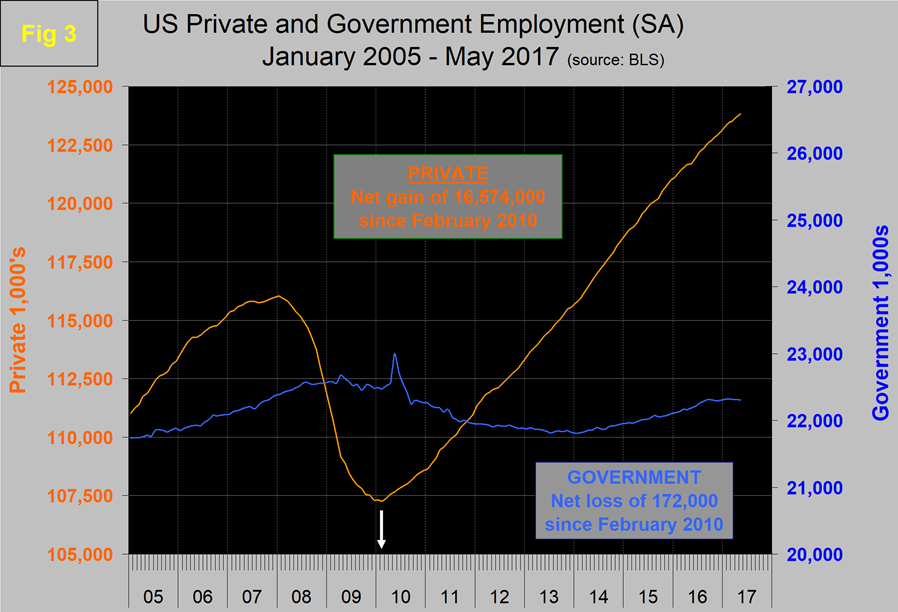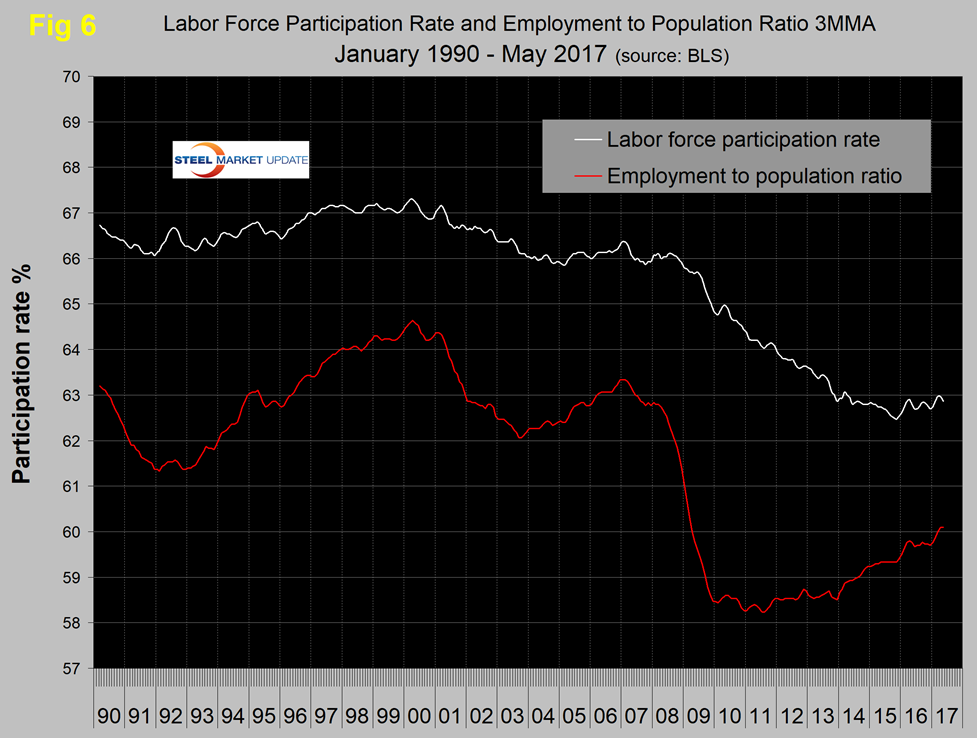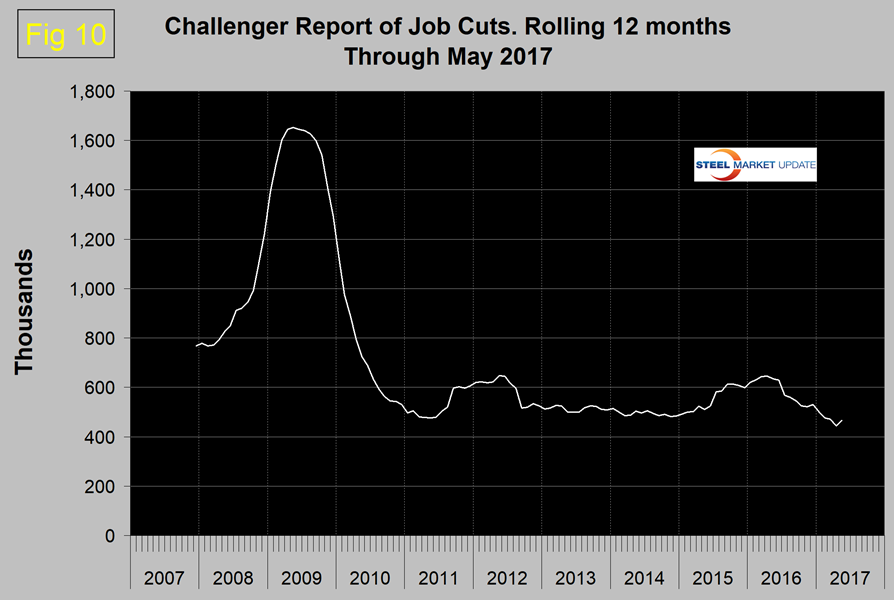Economy

Net Job Creation by Industry through May 2017
Written by Peter Wright
June 5, 2017
The Bureau of Labor Statistics (BLS) employment report for May was released on Friday and revealed a disappointing total net job creation of 138,000 which was well below analysts expectations. To make matters worse, March and April were revised down by a total of 66,000 jobs. Using a three month moving average (3MMA), the result for May was 121,000.
Figure 1 shows the 3MMA of the number of jobs created monthly since 2000 as the brown bars. These numbers are seasonally adjusted by the BLS.
In order to examine if any seasonality is left in the data after adjustment we have developed Figure 2.
In the seven years since and including 2011, job creation in May has been down by 23 percent. This year May was down by 21.0 percent therefore seasonally normal. The BLS has been criticized in the past for the ineffectiveness of their seasonal adjustment calculations. According to Moody’s some of the poor May result can be explained by calendar effects, as the survey week occurred early in the month and because May’s payrolls are affected by seasonal factors related to the end of school year. Moody’s Analytics expects that payroll gains will rebound in coming months, however employers will struggle to fill open positions. There are few indications on the horizon to suggest that the economy is at risk of a downturn. Although inflation remains low and wages growth is contained, Moody’s expect the Fed to continue on a slow path of tightening monetary policy. The weak payroll employment report will not keep the Fed from increasing its target rate later this month.
Total nonfarm payrolls are now 7,770,000 more than they were at the pre-recession high of January 2008. November 2014 was the first month for total non farm employment to exceed 140 million and in May was 146.1 million. The BLS reported that the average workweek for all employees on private nonfarm payrolls in May was unchanged at 34.4 hours. In manufacturing, the workweek also was unchanged at 40.7 hours, while overtime edged up by 0.1 hour to 3.3 hours. The average workweek for production and non-supervisory employees on private nonfarm payrolls edged down by 0.1 hour to 33.6 hours. In May, average hourly earnings for all employees on private nonfarm payrolls rose by 4 cents to $26.22. Over the year, average hourly earnings have risen by 63 cents, or 2.5 percent. In May, average hourly earnings of private-sector production and non-supervisory employees increased by 3 cents to $22.00.
Table 1 breaks total employment down into service and goods producing industries and then into private and government employees.
Most of the goods producing employees work in manufacturing and construction and the components of these two sectors that we consider to be of most relevance to steel people are broken out in Table 1. In May, 147,000 jobs were created in the private sector and government lost 9,000. The Federal government gained 8,000 as local governments lost 9,000 and state governments lost 8,000. Since February 2010, the employment low point, private employers have added 16,574,000 jobs as government has shed 172,000 (Figure 3).
In May service industries expanded by 122,000 as goods producing industries driven mainly by construction and manufacturing expanded by 16,000. Since February 2010, service industries have added 14,044,000 and goods producing 2,358,000 positions. This is part of the reason why wage growth has been slow since the recession as service industries on average pay less than goods producing such as manufacturing. As total employment was revised down by 66,000 jobs in March and April, goods producing was revised down by 8,000 jobs.
In May, manufacturing lost 1,000 positions which was the first decline of the year. So far in 2017 manufacturing has gained 55,000 jobs and is 0.5 percent higher than the same month in 2016. Table 1 shows that primary metals gained 2,900 jobs in May and is up by 9,000 ytd. Transportation equipment including aircraft gained 2,400 jobs in May but motor vehicles lost 1,500 positions. After the recession there was a steady gain in auto manufacturing jobs to 951,600 in August last year. Since then 7,900 jobs have been lost. Trucking was very strong in both February and March but lost ground in April and May. Oil and gas extraction gained 600 jobs in the preliminary May result and is up by 2,700 so far in 2017. Note the subcomponents of both manufacturing and construction shown in Table 1 don’t add up to the total because we have only included those that we think have most relevance to the steel industry.
Construction was reported to have gained 11,000 jobs in May and is up by 191,000 in the last 12 months or 2.9 percent. Some of the major construction sub categories are routinely reported one month in arrears which distorts the data in Table 1. These include, industrial buildings, commercial buildings and highways and streets. Construction has added 1,381,000 jobs and manufacturing 945,000 since the recessionary employment low point in February 2010 (Figure 4).
Construction has leapt ahead of manufacturing as a job creator but the growth of construction productivity is very low (or non-existent), in contrast to manufacturing where it has been historically high. The difference is the difficulty of automating construction jobs.
The official unemployment rate, U3, reported in the BLS’s Household survey (see explanation below) came in at 4.3 percent which was down from 4.7 percent in May last year. This number doesn’t take into account those who have stopped looking. The more comprehensive U6 unemployment rate was down from 9.7 percent in May last year to 8.4 percent in this latest report (Figure 5).
U6 includes workers working part time who desire full time work and people who want to work but are so discouraged that they have stopped looking. The differential between these rates was usually less than 4 percent before the recession and is now down to 4.1 percent. The employment participation rate at 62.7 in May was up from 62.6 percent in May last year but still the same as May 2015. We’re not sure what this is a percentage “of” because of the multiple descriptions of the labor pool. Another measure is the number employed as a percentage of the population which we think is much more definitive. In May this measure was 60.0 percent up from 59.7 percent in May last year and from 59.4 percent in May 2015. Until a year ago when it stalled, there was a gradual improvement in employment to population ratio since late 2011. Figure 6 shows both measures on one graph.
In the 29 months since and including January 2015 there has been an increase of 6,113,000 full time and a loss of 409,000 part time jobs. Figure 7 shows the rolling 12 month total change in both part time and full time employment.
This data comes from the household survey and part time is defined as <35 hours per week. Because the full time/part time data comes from the household survey and the headline job creation number comes from the establishment survey, the two cannot be compared in any particular month. To overcome the volatility in the part time numbers we have to look at longer time periods than a month or even a quarter which is why we look at a rolling 12 months for this component of the employment picture shown in Figure 7.
The job openings report known as JOLTS is reported on about the 10th of the month by the Federal Reserve and is over a month in arrears. Figure 8 shows the history of unfilled job openings through March when openings stood at 5,743,000 not far off the all-time high of 5,852,000 in March last year. There has been an improving trend since mid 2009.
Initial claims for unemployment insurance, reported weekly by the Department of Labor have continued their downward drift this year and in w /e May 27th were 248,000 with a four week moving average of 238,000. This marks the longest streak since 1973 of initial claims below 300,000. (Figure 9). The result for w/e February 4th 2017 at 231,000 was the lowest since March 1973.
The last piece of the employment puzzle that we examine is the Challenger report which measures job cuts monthly (Figure 10).
This data also tends to be quite erratic therefore again we examine a rolling 12 months and can see that job cuts decreased for most of 2016 and continued their downward trend in 2017.
SMU Comment: Overall we think the employment situation is very good and has been described as “full” by some analysts. May was the 78th consecutive month of job growth but Figure 1 shows a slowing trend since the middle of last year. This may not be a sign of a slowing economy but rather a lack of availability of qualified employees. In which case, we can expect an increase in wage driven inflation in the near future. The results for manufacturing and construction are sign posts for steel sales activity. In the big picture, layoffs are historically low and job openings are close to all-time highs therefore 2017 is tracking well.
Explanation: On the first Friday of each month the Bureau of Labor Statistics releases the employment data for the previous month. Data is available at www.bls.gov. The BLS reports on the results of two surveys. The Establishment survey reports the actual number employed by industry. The Household survey reports on the unemployment rate, participation rate, earnings, average workweek, the breakout into full time and part time workers and lots more details describing the age breakdown of the unemployed, reasons for and duration of unemployment. At SMU we track the job creation numbers by many different categories. The BLS data base is a reality check for other economic data streams such as manufacturing and construction and we include the net job creation figures for those two sectors in our “Key Indicators” report. It is easy to drill down into the BLS data base to obtain employment data for many sub sectors of the economy. For example, among hundreds of sub-indexes are truck transportation, auto production and primary metals production. The important point about each of these hundreds of data streams is in which direction they are headed. Whenever possible we at SMU try to track three separate data sources for a given steel related sector of the economy. We believe this gives a reasonable picture of market direction. The BLS data is one of the most important sources of fine grained economic data that we use in our analyses. The States also collect their own employment numbers independently of the BLS. The compiled state data compares well with the federal data. Every three months SMU examines the state data and provides a regional report which indicates strength of weakness on a geographic basis. Reports by individual state can be produced on request.

Peter Wright
Read more from Peter WrightLatest in Economy

ISM September survey captures deepening manufacturing gloom
The Institute for Supply Management’s (ISM) latest monthly report on manufacturing reflects a bleak view of American industry in September.

Key industries concerned over government shutdown’s impact on steel, manufacturing
Trade groups cautioned that a prolonged shutdown could strain US industry.

Chicago Business Barometer catches cold winds of contraction in September
The Chicago Business Barometer's September reading indicates a softening in overall business activity in the Midwest for the third consecutive month, with new orders and backlogs retreating further.

Metalforming market sentiment takes a dive in September: PMA
Metalforming manufacturers anticipate a decrease in near-term conditions, according to the Precision Metalforming Association's (PMA) Business Conditions Report for September.

AIA: Architecture firms still under pressure
Architecture firms reported a modest improvement in billings through August, yet business conditions remained soft, according to the latest Architecture Billings Index (ABI) release from the American Institute of Architects (AIA) and Deltek.











